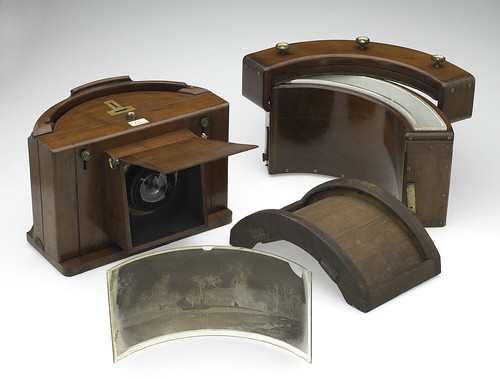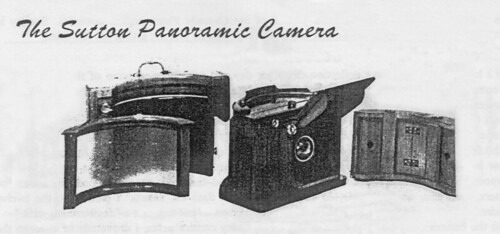Sutton's Panoramic Camera

|
| Sutton Panoramic camera image by Ron (Netherlands) (Image rights) |
Thomas Sutton's Panoramic Camera is a wooden-bodied camera for wet-plate panoramic photography on curved glass plates.
Thomas Sutton first patented the lens on which the camera relies, in September 1859.[1][2] The lens is constructed as two glass hemispheres, enclosing a water-filled spherical space. Supposedly, Sutton was inspired by the view through a 'snowstorm' souvenir from Paris;[1] however, the glass parts of the lens are thick-walled: in the example in the Museum of the History of Science in Oxford, the glass hemispheres are 80 mm in diameter, and enclose a 36 mm-diameter space. In the central space, there is a diaphragm, shaped to equalise the exposure across the wide view.[1][2] The lens is an f/12.
The camera makes exposures on glass plates, curved through about 100 degrees. These would be coated with emulsion by the user, and dipped in sensitising silver nitrate solution immediately before exposure.[3] For focussing, the camera has a similarly curved focusing screen.[4] The focusing control is a screw on the back of the camera, below the screen or plate-holder.
The lens is mounted in a board allowing a small amount of rise. There is a shallow wooden hood surrounding the lens. The wooden flap covering this is the shutter; it is manually operated. There are left-right and front-rear spirit levels on the top of the body. There is no viewfinder.
The camera was to be made by Frederick Cox of London, who announced it as available in four sizes early in 1860. However, Cox was unable to make the camera successfully, and Thomas Ross took over the production of it in 1861. Ross had more success with the camera, and later bought Sutton's patent, improved on the the design, and made the camera in three sizes, according to the article in Sphaera:[1] however, Early Photography cites a 1863 catalogue by Bland offering four sizes: 5x10½ and 6½x14 inch (for which examples are linked below), 8x17 and 10x30 inch.[2][5] It must be remembered that the images on the curved plates could not be enlarged, so, though unwieldy, expensive and fragile, large plates would be the only way to make large prints.
Lomography have made two of their novelty cameras with a lens with a liquid-filled element, labelled Sutton's Liquid Filled Lens 80mm.[6] Neither holds the film in a curve.

|
scanned by Geoff Harrisson (Image rights) |
Notes
- ↑ 1.0 1.1 1.2 1.3 'W.D.H.' Sphere No. 8: Thomas Sutton's Panoramic Camera Lens, in Sphaera: the Newsletter of the Museum of the History of Science, Oxford, Issue 8, autumn 1998.
- ↑ 2.0 2.1 2.2 Sutton's panoramic lens, at Early Photography
- ↑ Sutton camera with sensitising tank (a ceramic tank in a wooden case), printing frame and an exposed plate, in the Melborne Museum, Melbourne, Australia.
- ↑ Sutton camera with focusing screen, sold in May 2006 (for £33,600) at Christie's in London.
- ↑ The catalogue referred to at Early Photography is probably the one bound into the back of Charles A. Long (1864) Practical Photography on Glass and Paper, published by Negretti and Zambra. The catalogue is about as large as the book itself. Sutton's camera appears on pages 13-15 of the catalogue section (about pages 97-100 (of 200) of the digitised document, depending which format is viewed). From the Bodleian Library, and digitised by Google in various formats, at the Internet Archive; there are also earlier editions of the same book, from 1854 and 1856 (too early to list Sutton's camera), published by Bland themselves.
- ↑ Lomomod No. 1 card-bodied camera kit for 120 film, and Hydrochrome Sutton's Panoramic Belair plastic-bodied panoramic camera for 35mm film, both with water-filled lens, at Lomography.
Links
- Ross-Sutton camera for approx. 6½x14 inch plates, with two plate holders and a printing frame, in the Spira Collection (archived) Not shown, but referred to, is a suction cup for holding the plates while coating them with emulsion.
- Sutton camera for 140x250 mm (approx. 5x10 inch) plates, in the exhibition Cameras: the Technology of Photographic Imaging, at the Museum of the History of Science, Oxford, 20 May - 13 September, 1997.